Organisms in the environment do not live in isolation. They interact in a variety of ways.
![]() Study the following illustration closely.
Study the following illustration closely.
Using your notes, list all the interactions that you see.
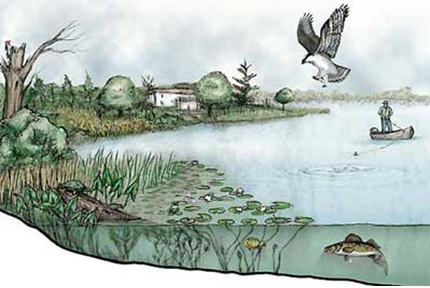
There are three major types of interactions between species: competition, predation, and symbiosis.
Let's look at these interactions one at a time:
Competition is defined as two species fighting for the same resources. Animals compete for food to eat and water to drink. They also need a certain amount of space in which to find food, water, shelter, and opportunities to mate.
Plants also compete for resources. They need light as an energy source for photosynthesis. Plants also compete for space, minerals, and water.
Unfortunately there are not enough of these resources to go around. As a result of this scarcity of resources, there is competition between living organisms in their environment.
![]() Look at the images below. What resources are these plants and animals competing for?
Look at the images below. What resources are these plants and animals competing for?
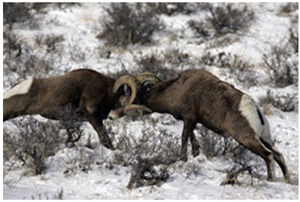
|
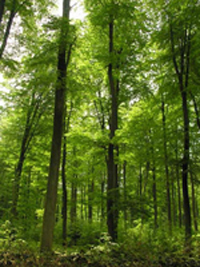 |
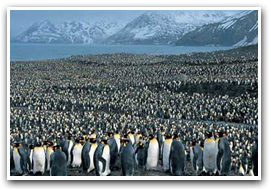 |
Interactive popup. Assistance may be required.
The rams might be competing for space, food, or a mate.
The trees could be competing for sunlight and water.
The penguins are competing for space and food.

Virtually all animals, because we are not producers, must eat other organisms to obtain energy and nutrients. What are some things humans eat? We buy food in grocery stores, but if we were still hunting in the wild, we would be predators for food like chickens and buffalo and plants. Predation is when one organism eats another. Predators can affect the size of prey populations in a community and determine the places prey can live and feed. |
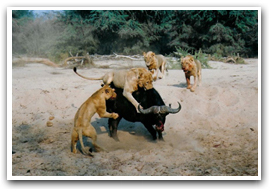
|
|
Interactions between herbivores and plants are as important as interactions between predator and prey. An interaction in which one animal feeds on producers is herbivory. Herbivores can determine the places that certain plants can grow and survive. |
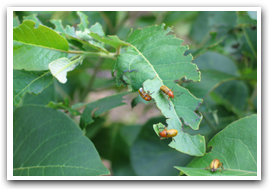
|
Any relationship in which two species live closely together is called symbiosis. There are three main types of symbiosis: mutualism, commensalism, and parasitism.
Mutualism is a type of symbiosis in which both organisms benefit. In this picture, ants are living in an acacia plant. The ants have a home inside the hollow stem of the acacia. They also get sugar from the plant. The acacia produces small spots of sugar at the base of each leaf. The plant also benefits. If you try to munch on the acacia's leaves, you will know why! The ants attack anything that tries to eat the acacia's leaves. Mutualism is often represented with two plus signs showing that both organisms benefit. + + |
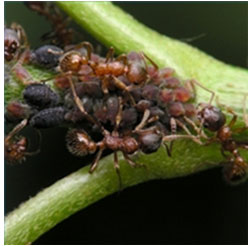
|
|
|
Commensalism is a relationship in which one organism benefits and the other is not affected. Orchids can illustrate this. Orchids are epiphytes (plants that grow on other plants). They grow high in the canopy of rainforests on the branches of trees. The orchids benefit in several ways. The main benefit is probably that they can get more sunlight. In addition, they may be more easily visited by the moths which pollinate them. Also, because they are up high the wind can more easily catch and spread their tiny seeds. Orchids do not harm the trees they grow in. Their roots stay on the bark of the tree; they do not take water or nutrients from the tree. Commensalism is represented with a plus sign and a zero showing that one organism benefits and the other is not affected. + 0 |
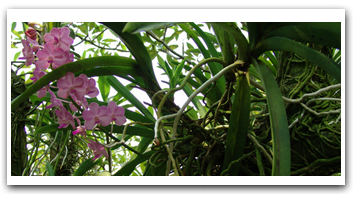 |
|
Parasitism is when one organism benefits and one is hurt by the relationship. This strangler fig growing on another tree is an example of parasitism. The fig is getting support so it can grow quickly and get more sunlight. Although the fig doesn't really strangle the tree, it does make it harder for the tree to get water and nutrients from the soil and also blocks some of the sunlight from reaching the tree's leaves. Parasitism is represented with a plus sign and a minus sign showing that one organism benefits and the other is harmed. + - | 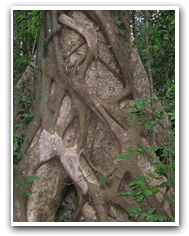
|
Sources for images used in this section as they appear, from top to bottom: